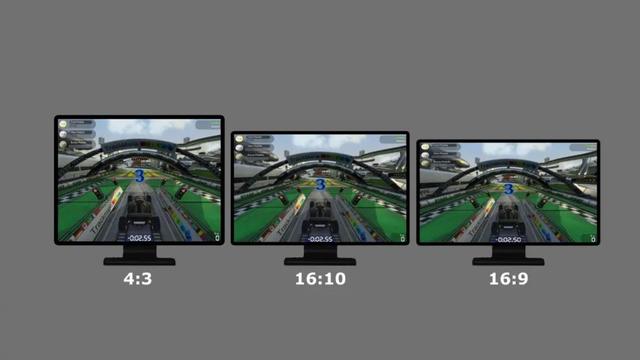
When selecting a monitor, the aspect ratio is a pivotal factor that defines your viewing and working experience. Are you seeking a monitor for gaming, professional tasks, or watching movies? The 4:3 and 16:9 aspect ratios, each with their unique attributes, offer varied experiences. This guide delves into these two popular aspect ratios, helping you decide the best fit for your specific needs.
So, which is the best aspect ratio for your monitor? If you prioritize focused content or retro gaming, the 4:3 aspect ratio with its square-like view is ideal. However, if you’re looking for an expansive view for modern multimedia, the 16:9 aspect ratio is your go-to. Your choice ultimately depends on what you value more in your digital interaction.
This decision is more than just a technicality; it’s about how you interact with the digital world, be it through gaming, professional software, or enjoying cinematic experiences.
What is the Aspect Ratio?
At its core, the aspect ratio of a monitor refers to the proportional relationship between its width and height. This seemingly simple characteristic is crucial in determining how content is displayed, affecting everything from the layout of graphics to the immersion level in video content.
What is the History and Evolution of Aspect Ratios?
The journey from the traditional 4:3 aspect ratio to the widescreen 16:9 is a tale of technological evolution. Originally mirroring the format of classic television sets, the 4:3 aspect ratio was once the standard. However, as multimedia and digital content evolved, so did the preference for wider screens, leading to the dominance of the 16:9 aspect ratio in today’s market.

What Advantages Does a 4:3 Aspect Ratio Monitor Offer?
The 4:3 aspect ratio is commonly found in photography and some medium format film cameras, like Micro Four Thirds cameras, and is known for its ability to capture depth in landscape photography and intimate single or couple portraits. In the context of monitors, this aspect ratio is beneficial for specific professional tasks where a more squared screen is advantageous, offering a comprehensive vertical view which can be essential in coding, text editing, and reading.
How Does a 16:9 Aspect Ratio Enhance Modern Multimedia?
The 16:9 aspect ratio is the most popular choice for video because it matches the widescreen format of most modern devices like computer monitors, tablets, smartphones, and TVs. This aspect ratio became the standard definition for digital HDTV, Full HD, and SD, making it ideal for modern video content, gaming, and web browsing. It offers a broader horizontal field, perfect for establishing shots in videos and accommodating multiple open windows in a work setting
Head-to-Head Comparison
When comparing these two aspect ratios, the choice hinges on the intended use. The 4:3 is best for specialized tasks and nostalgia, offering a focused and compact view, while 16:9 excels in providing a broad and immersive experience, ideal for modern multimedia consumption and gaming.
What Resolutions Are Typical for 4:3 and 16:9 Aspect Ratio Monitors?
For 4:3 Aspect Ratio Monitors:
- 640×480 (VGA): Basic resolution suitable for older displays and certain industrial applications.
- 800×600 (SVGA): Offers better clarity than VGA and is commonly used in industrial settings.
- 1024×768 (XGA): Standard resolution for 4:3 monitors, suitable for various applications.
- 1280×960: Provides a slightly higher resolution for more detailed work.
- 1600×1200 (UXGA): High-resolution option for precise applications like medical displays.
- 2048×1536 (QXGA): Used in specialized industrial settings for sharp visuals.
For 16:9 Aspect Ratio Monitors:
- 1366×768 (HD): Basic HD resolution suitable for smaller displays and budget applications.
- 1920×1080 (Full HD): The most common resolution for 16:9 monitors, widely used in B2B applications for high-definition quality.
- 2560×1440 (QHD): Quad HD resolution for better clarity, often used in design and engineering applications.
- 3840×2160 (4K Ultra HD): Offers even higher clarity and is suitable for applications where intricate details are crucial.
- 5120×2880 (5K): Provides exceptional detail, used in fields where visual accuracy is paramount, such as video editing and graphic design.
- 7680×4320 (8K): Cutting-edge 8K resolution for applications requiring the highest level of detail.
Why Has the Shift from 4:3 to 16:9 Monitors Occurred?
The shift from 4:3 to 16:9 in monitors reflects the evolution of media content towards widescreen formats. This change accommodates the growing trend of multimedia consumption that requires a broader viewing area for an enhanced experience, aligning with the widescreen format of most modern digital content
Is a 4:3 Monitor Still Relevant in Today’s Market?
While less common, 4:3 monitors still have relevance, particularly in professional settings or specific niches where the unique vertical space they offer is beneficial. They are also favored in retro gaming and applications originally designed for this aspect ratio.
What’s The Future of Monitor Aspect Ratios
With the advent of ultrawide and curved monitors, the landscape is evolving. The future of monitors seems to be veering towards even wider aspect ratios like 21:9, offering even greater immersion and productivity benefits. As content and technology continue to evolve, so too will the standards for monitor aspect ratios.
Conclusion
Your choice between a 4:3 and 16:9 monitor should align with your specific needs and preferences. Whether for professional tasks, gaming, or multimedia enjoyment, the right aspect ratio can enhance your overall experience.





